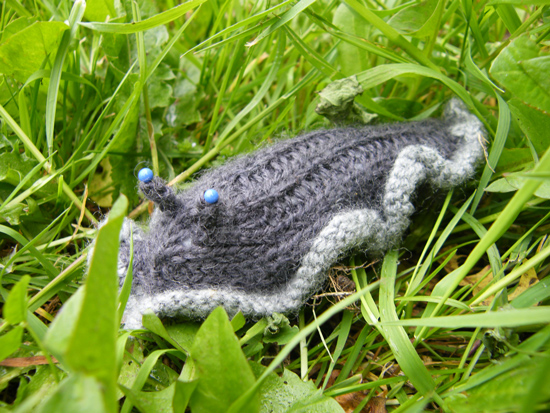
Crocheted slug (we couldn’t help it!)
They come out on cool, wet nights. They devour seedlings and fruits of large numbers of crops, and can seriously damage or kill mature plants in the garden. During warm, sunny days they hide under rocks, logs, or in weedy areas. They are prolific producers of eggs, and baby slugs are ready to eat your plants as soon as they are born. Gardeners hate them and have devised many methods to control their numbers, because total elimination of these “houseless snails” from gardens is nearly impossible.
World-wide, there are many different kinds of snails, and they are not all vegetarian. But the ones that homeowners care about are the ones that will damage or destroy ornamentals, vegetable plants, and consume or disfigure harvests of many fruit varieties. Slugs (and snails, which often also occur in the same garden) are masters of climbing plant stems and leaves because they produce thick, sticky mucus that allows them to adhere to and move over almost any surface. Slugs also use this mucus for protection, since the slipperiness of their bodies makes it hard for a potential predator to hang onto them. The body of the slug is mostly made of water, and the slime also keeps them from drying out rapidly.
Slugs can range in size from a fraction of an inch for a newly-hatched individual, to several inches long for some varieties. They come in many colors from pale gray to rich, walnut brown hues and every other color and shade inbetween. All slugs have two pairs of antennae, which they use for vision and a sense of smell. They have rasping mouth parts, and the damage they inflict is mostly visible as irregularly shaped holes in leaves and on fruit surfaces. Every slug has both sets of sex organs, but two individuals most cross-fertilize to produce viable eggs.
An internet search for slug control typically yields dozens of different approaches, ranging from “organic” methods to chemical treatments. Most people are familiar with the “stale beer” method of luring slugs to the liquid, only to drown. But, dear reader, save the beer for another use; slugs are drawn not to the alcohol, but to the yeast in the brew. It is a lot cheaper to make a bowl of water with a bit of baker’s yeast than to buy even the least expensive brand of beer. Other methods include the use of cornmeal (to bloat the animal’s intestine), attracting them with pet food, cabbage leaves, strawberries and other fruit, and several other lures to gather and then destroy them. Some people prefer a copper coil barrier or diatomaceous earth (made from the abrasive glass like bodies of microscopic organisms), but these methods can become expensive and don’t always work satisfactorily.
When my wife and I first established our garden at our present location, we spent every late summer evening on “slug patrol.” Armed with disposable gloves and a bucket of soapy water, each of us collected hundreds of slugs daily to try to reduce their numbers. The effort eventually paid off, and our slug population is now manageable in most years. I say “most years,” because winter and early spring conditions have a lot to do with the ultimate summer size of the population. Mild winters allow for greater survival rates of eggs and adults, and cool and wet springs can increase their numbers manyfold in a short time.
Lately, I have begun to add iron phosphate to my arsenal to combat slugs. Sold under various trade names, this chemical is harmless to plants and wildlife or domestic pets when applied in accordance with the pesticide manufacturer’s label, but slugs seem to enjoy eating it. I have watched many a slug happily rasping on the solid pellets of iron phosphate as soon as I scatter it on the ground. Then they crawl away and die in a day or two.
There is no silver bullet for controlling slugs. Any cultural method (e.g. eliminating or reducing weeds around the garden, staking tomato plants, etc.), along with a good estimate of their numbers, combined with several different types of approaches to keep their populations in check can ensure that an adequate and attractive crop of fruits and vegetables will be harvested during the growing season.
Steven Jakobi is a Master Gardener Volunteer at Cornell Cooperative Extension of Allegany County.
Views: 44






